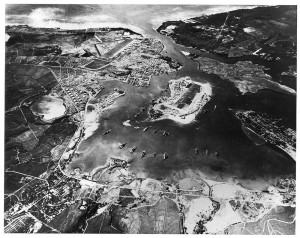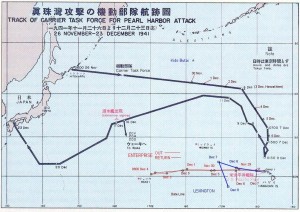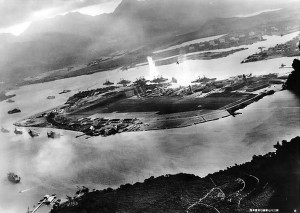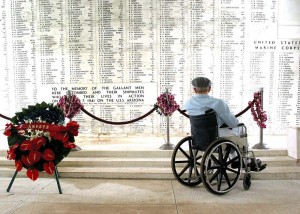 On the calm Sunday morning of December 7, 1941, the Japanese shocked the entire world by launching a surprise attack on the American Naval base at Pearl Harbor in Hawaii. The two hour attack on Pearl Harbor led to the death of 2,400 Americans, the destruction of 188 U.S. air-crafts and the sinking or damage of 21 battle ships. The attack was a turning point for the United States and also for the war.
On the calm Sunday morning of December 7, 1941, the Japanese shocked the entire world by launching a surprise attack on the American Naval base at Pearl Harbor in Hawaii. The two hour attack on Pearl Harbor led to the death of 2,400 Americans, the destruction of 188 U.S. air-crafts and the sinking or damage of 21 battle ships. The attack was a turning point for the United States and also for the war.
On the next day, December 8th, the entire nation was gathered around their radios to hear President Franklin D. Roosevelt deliver the renowned “Day of Infamy” speech. This is the same day that America officially abandoned its policy of isolationism when congress declared war on Japan. Two days later, congress also declared war on Germany.
Events Leading Up To the Attack
The road to war between the U.S. and Japan began in the 1930s when the two nations were driven apart because of their differences over Japan’s conquest of China. By the end of 1931, Japan had already conquered the Manchuria region. This is what motivated Japan to begin a long and eventually unsuccessful campaign to conquer the whole of China. In order to further their ambition, the Japanese government decided to ally themselves with Nazi Germany in what was dubbed the Axis Alliance, and in the following year, they occupied the whole of Indochina.
Due to their economic and political interests in East Asia, the United States was subsequently alarmed by Japan’s actions. This led to the increase of U.S. financial and military aid to China and the cutting off of shipment of oil and other raw materials to Japan. Since Japan was poor in natural resources, the Japanese government viewed the actions of the U.S. as a threat to their nation’s survival. Despite the restrictive embargo America had placed on Japan, the Japanese continued with their plans of expansion in Asia knowing their actions could lead to war between the two nations.
Japan Plans Its Attack
 The Japanese knew that the United States Pacific Fleet at Pearl Harbor posed a great danger to their plans on the onset of war. Admiral Isoroku Yamamoto, commander of the Japanese naval fleet, devised an elaborate plan to completely immobilize the U.S. Pacific Fleet with a surprise attack. The key elements of the plan were the use of naval aviation and aircraft carriers, the element of surprise, and meticulous preparation. Japanese carrier pilots began their intense training in special tactics specifically for the attack on Pearl Harbor.
The Japanese knew that the United States Pacific Fleet at Pearl Harbor posed a great danger to their plans on the onset of war. Admiral Isoroku Yamamoto, commander of the Japanese naval fleet, devised an elaborate plan to completely immobilize the U.S. Pacific Fleet with a surprise attack. The key elements of the plan were the use of naval aviation and aircraft carriers, the element of surprise, and meticulous preparation. Japanese carrier pilots began their intense training in special tactics specifically for the attack on Pearl Harbor.
The plans were approved by the naval general staff in October 1941 and on November 26, 1941 the attack force began their 3,000 mile journey across the pacific. In order to successfully sneak three submarines, two heavy cruisers, one light cruiser, nine destroyers, six aircraft carriers, and two battleships across the Pacific without being spotted, they had to zigzag and avoid the major shipping lines. Within a week and a half, they arrived at their destination safely with the fleet camped about 230 miles north of the Hawaiian Island of Oahu.
The Surprise Attack
For most of the Military personnel at Pearl Harbor, Sunday morning was a time of relaxation and leisure. On the morning of December 7, 1941, most of them were either getting ready for church, eating breakfast at the mess hall or still asleep. They had absolutely no knowledge of an imminent attack.
At around 8 a.m., the explosions began. Low-flying enemy air crafts, pillars of smoke and loud booms shocked several of them into the realization that Pearl Harbor was really under attack and that the current events were not a training exercise.
Regardless of the fact that it was a surprise attack, most of the American Naval Officers were able to act quickly. Within five minutes, many gunners were already at their anti-aircraft gun trying to shoot down the enemy planes. At exactly eight that morning, Admiral Husband Kimmel hurriedly sent out a dispatch to everyone in the U.S. naval fleet, “AIR RAID ON PEARL HARBOR X THIS IS NOT DRILL”.
The Attack on Battleship Row
 The Japanese were hoping to destroy U.S. aircraft carriers at Pearl Harbor. However, fortunately for the U.S., on that day the aircraft carriers had been sent out to sea. The other major naval targets on their list were the battleships. That morning, there were eight United States battleships docked at Pearl Harbor. Seven of the battleships were lined up at what was known as Battleship row; the remaining ship was at dry dock due to maintenance and repairs. Since the attack was a complete surprise, most of the first bombs and torpedoes dropped on the battleships hit their targets causing severe damage.
The Japanese were hoping to destroy U.S. aircraft carriers at Pearl Harbor. However, fortunately for the U.S., on that day the aircraft carriers had been sent out to sea. The other major naval targets on their list were the battleships. That morning, there were eight United States battleships docked at Pearl Harbor. Seven of the battleships were lined up at what was known as Battleship row; the remaining ship was at dry dock due to maintenance and repairs. Since the attack was a complete surprise, most of the first bombs and torpedoes dropped on the battleships hit their targets causing severe damage.
The Seven Battleships
The West Virginia sank quickly after being hit by nine torpedoes. The Tennessee was only hit by two bombs but was severely damaged by oil fires after the nearby Arizona blew up. It was one of the ships that stayed afloat. The Oklahoma was hit by about nine torpedoes to the extent that it turned nearly upside down. Most of the crew remained trapped on board and only 32 were saved from the wreckage. The California was first struck by two torpedoes then later hit by a bomb. It sank three days after the attack on Pearl Harbor due to uncontrolled flooding. The Maryland, despite being hit by two bombs, was not heavily damaged. 30 minutes after it was hit by a torpedo, the Nevada left battleship row and began heading towards the entrance of the harbor. The damage caused by the Japanese bombers forced the ship to beach itself. The Arizona was struck by several bombs, with one of the bombs causing a massive explosion which almost immediately sank the ship. The Arizona claimed the worst fatality rate with about 1,100 of her crew killed. A memorial was placed over the ship’s wreckage.
 The Japanese had launched 5 midget submarines to aid in the attack against the battleships. However, all five of the subs were completely destroyed during the attack.
The Japanese had launched 5 midget submarines to aid in the attack against the battleships. However, all five of the subs were completely destroyed during the attack.
While the fleet anchored at Pearl Harbor was being hit, a similar attack was being orchestrated on military airfields. The Army Air Corps fields at Bellows, Hickam, and Wheeler and the Navy air bases at Kaneohe Bay and Ford Island were all bombed. The intention behind the simultaneous attack was to destroy all the American planes before they could rise to intercept Japanese air-crafts.
Roughly two hours after the attack had started, four battleships were sunk and the others were severely damaged. Four auxiliaries, one minelayer, four destroyers, three light cruisers, and one target ship had been damaged. The Japanese also managed to completely destroy 188 U.S. air-crafts and damage an additional 159. 1,143 servicemen were injured and 2,335 lost their lives. 68 civilians also died as a result of the attack.